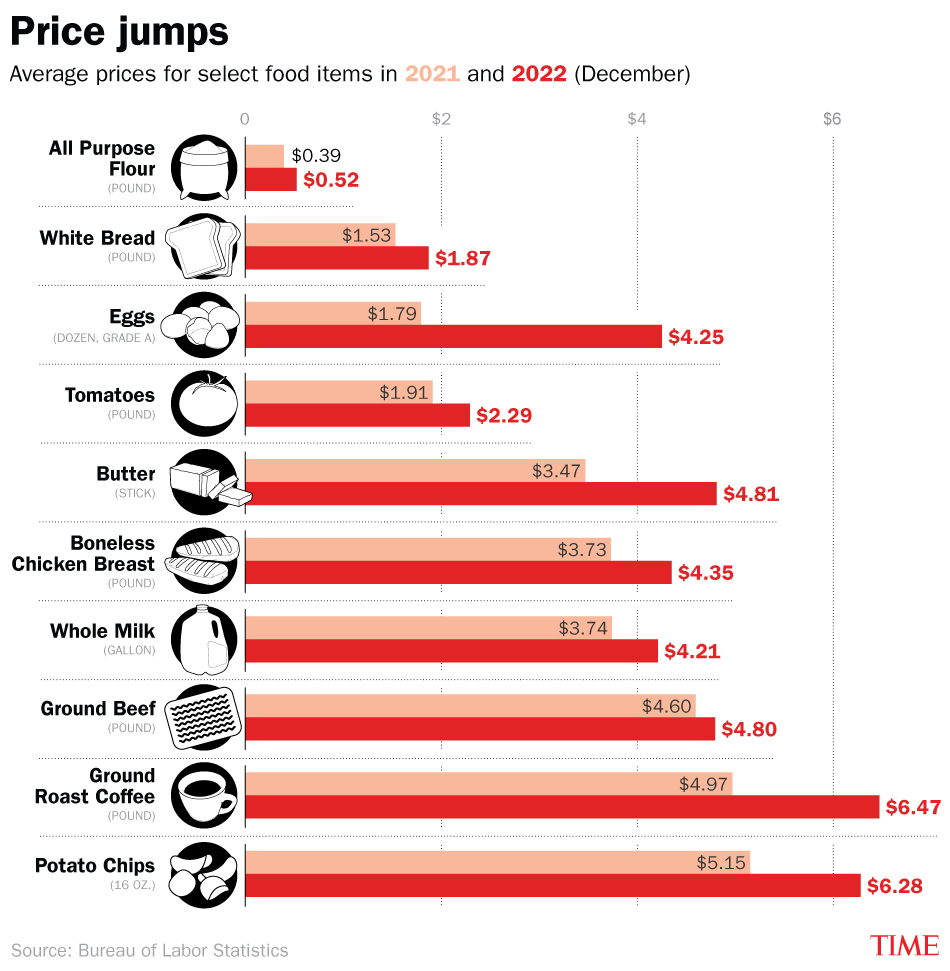Grocery Inflation: 3 Months Of Rising Food Costs

Table of Contents
Understanding the Drivers of Grocery Inflation
Several interconnected factors contribute to the current wave of grocery inflation. Understanding these drivers is crucial to mitigating their impact and developing effective coping strategies.
Supply Chain Disruptions
Ongoing supply chain issues continue to plague the food industry, significantly impacting production and distribution. These disruptions translate directly into higher prices at the grocery store.
- Increased Transportation Costs: Fuel prices have skyrocketed, increasing the cost of transporting goods from farms to processing plants and ultimately to grocery stores.
- Labor Shortages: A persistent lack of workers in various sectors of the food industry, from farming to trucking, slows down production and increases labor costs.
- Port Congestion: Delays at major ports worldwide continue to bottleneck the flow of imported food products, further limiting supply and driving up prices.
- Geopolitical Instability: The war in Ukraine, for example, has significantly disrupted global wheat and sunflower oil supplies, impacting food prices worldwide.
These interconnected factors create a perfect storm, pushing the cost of food higher for consumers.
Increased Energy Costs
The rising cost of energy plays a crucial role in driving up food prices. Energy is a fundamental input across the entire food system.
- Impact on Farming: Farming is energy-intensive, requiring fuel for machinery, irrigation, and fertilizer production. Higher energy prices directly increase the cost of producing crops.
- Processing and Packaging: Food processing and packaging rely heavily on energy, making these stages more expensive as energy costs rise.
- Delivery and Transportation: As previously mentioned, the cost of transporting food from farm to table is directly linked to fuel prices.
The ripple effect of increased energy costs is felt throughout the food supply chain, ultimately resulting in higher prices for consumers.
Extreme Weather Events
Climate change is exacerbating extreme weather events, impacting crop yields and livestock production, thus contributing to grocery inflation.
- Droughts and Floods: Severe droughts in key agricultural regions reduce crop yields, leading to shortages and price increases. Conversely, floods can destroy crops and disrupt transportation networks.
- Heat Waves: Extreme heat can damage crops and reduce livestock productivity, leading to reduced supply and higher prices.
- Long-Term Effects of Climate Change: The increasing frequency and intensity of extreme weather events pose a significant long-term threat to food security and global food prices.
These unpredictable and often devastating events contribute to food shortages and drive up prices, making grocery shopping more challenging for everyone.
The Impact of Grocery Inflation on Consumers
The surge in grocery inflation has far-reaching consequences for consumers, impacting their budgets and well-being.
Increased Food Insecurity
Rising food costs are exacerbating food insecurity, particularly among vulnerable populations.
- Statistics on Food Insecurity: Recent studies show a concerning increase in the number of households struggling to afford adequate food.
- Impact on Families and Individuals: Families are forced to make difficult choices, often sacrificing other necessities to put food on the table. Individuals may skip meals or resort to less nutritious, cheaper options.
The social and economic consequences of rising food prices are significant and far-reaching.
Changes in Consumer Behavior
Consumers are adapting to higher grocery bills by altering their shopping habits.
- Shopping at Discount Stores: More people are turning to budget-friendly grocery stores and seeking out deals and discounts.
- Buying Less Meat: Meat is often a more expensive protein source, leading many to reduce their meat consumption or replace it with cheaper alternatives.
- Switching to Cheaper Brands: Consumers are increasingly opting for store brands and less expensive alternatives to name brands.
- Reducing Food Waste: Minimizing food waste is becoming more crucial as consumers strive to make the most of their grocery purchases.
These behavioral changes reflect the significant impact of grocery inflation on everyday life.
Impact on Household Budgets
The increased cost of groceries puts a substantial strain on household budgets.
- Reduced Spending on Other Necessities: Rising food costs often force families to cut back on other essential expenses, such as healthcare, utilities, or transportation.
- Less Discretionary Spending: Higher grocery bills leave less money available for leisure activities, entertainment, or savings.
Managing a budget in the face of grocery inflation requires careful planning and potentially difficult choices.
Strategies for Managing Rising Grocery Costs
Despite the challenges, there are strategies to mitigate the impact of grocery inflation on your household budget.
Smart Shopping Techniques
Implementing smart shopping habits can significantly reduce your grocery bill.
- Meal Planning: Planning meals in advance helps avoid impulse purchases and ensures you only buy what you need.
- Using Coupons and Discounts: Take advantage of coupons, loyalty programs, and store sales to save money.
- Comparing Prices: Compare prices across different stores and brands to find the best deals.
- Buying in Bulk (When Appropriate): Buying non-perishable items in bulk can be cost-effective, but be mindful of storage space and potential spoilage.
- Growing Your Own Food: Even a small herb garden or a few tomato plants can help reduce your grocery bill.
Reducing Food Waste
Reducing food waste is a simple yet effective way to save money and minimize your environmental impact.
- Proper Food Storage: Store food correctly to extend its shelf life.
- Using Leftovers Creatively: Transform leftovers into new meals to avoid throwing away food.
- Planning Meals Based on Available Ingredients: Use up ingredients before they spoil by planning meals around them.
Seeking Financial Assistance
If you're struggling to afford groceries, explore available resources to help.
- Food Banks: Food banks provide essential food assistance to those in need.
- Government Assistance Programs: Many governments offer food assistance programs for low-income families.
- Community Support Initiatives: Local charities and community organizations may offer supplemental food assistance.
Conclusion: Navigating the Challenges of Grocery Inflation
The three-month surge in grocery inflation is driven by a complex interplay of supply chain disruptions, increased energy costs, and extreme weather events. This has led to increased food insecurity, changes in consumer behavior, and significant strain on household budgets. However, by understanding the factors contributing to grocery inflation and implementing the strategies outlined above—smart shopping techniques, reducing food waste, and seeking financial assistance where needed—you can effectively navigate these challenging economic times. Stay informed about grocery inflation trends and take control of your food budget today!

Featured Posts
-
 Remont Pivdennogo Mostu Khto Skilki I Koli Detalniy Analiz
May 22, 2025
Remont Pivdennogo Mostu Khto Skilki I Koli Detalniy Analiz
May 22, 2025 -
 Chinas Impact On Bmw And Porsche Sales More Than Just A Market Slowdown
May 22, 2025
Chinas Impact On Bmw And Porsche Sales More Than Just A Market Slowdown
May 22, 2025 -
 Groeiend Autobezit Stuwt Occasionverkoop Bij Abn Amro
May 22, 2025
Groeiend Autobezit Stuwt Occasionverkoop Bij Abn Amro
May 22, 2025 -
 I Hope You Rot In Hell You Snowflake Pub Landlords Verbal Attack On Leaving Staff
May 22, 2025
I Hope You Rot In Hell You Snowflake Pub Landlords Verbal Attack On Leaving Staff
May 22, 2025 -
 Noul Serial Netflix O Distributie De Oscar Si O Poveste Captivanta
May 22, 2025
Noul Serial Netflix O Distributie De Oscar Si O Poveste Captivanta
May 22, 2025
